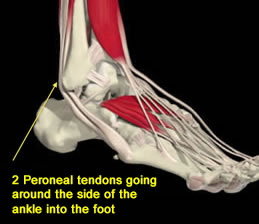Peroneal Tendon Problems
What are the Peroneal tendons?
Behind the prominent bump on the outside of your ankle lie 2 tendons. They run down from the outside of your leg from below the knee and go behind the ankle and into the foot. Behind the ankle they are securely “tied down” within a smooth tunnel to allow the tendons to move freely like going through a pulley. They help move and stabilise the foot, especially in helping to turn your foot sideways (to the outside).

How can they become a painful problem?
- Acute injury, tears and tendon dislocation
Like any tissue it can be torn or stretched from an unforced injury. The tendon can move from being relatively hidden behind your ankle bone to the side of or even in front of your ankle bone
- Acute inflammation of the tendon tunnel or tendonitis
Quite sudden pain and discomfort can occur with inflammation of the area, this can be associated with overuse/new activity
- Chronic degeneration of the tendon or tendinosis
More chronic symptoms with possibly an initial injury previously can lead to wear and tear in the tendon and problems.
Conditions that can pre-dispose you to developing problems are high arched feet, people with systemic arthritis like rheumatoid or Diabetes.
What are the symptoms?
- Acute injuries or tendinitis can present with pain, swelling and heat with a visual or feeling of popping or snapping of the tendon by the outside at the ankle. Patients can complain of their ankle giving way and feeling unstable, or just severely painful on activity
- Chronic degenerate problems often present with a constant pain and swelling on the ankle and persistent weakness or instability in the ankle and difficulty in performing high intensity exercise
How is the condition diagnosed?
Accurate clinical assessment is vital to diagnose an acute injury that can often be missed and overlooked for a simple ankle ligament sprain. X-Rays can sometimes show a flake of bone from the ankle bone if the tendon has dislocated or calcium build up around the tendon, if severely degenerate. Otherwise an Ultrasound is useful to inspect the tendon whilst the patient moves to look for splits or dislocation. MRI can also be done.
Can the problem get worse?
Yes. It is important to get rapidly assessed by a foot and ankle surgeon to ensure correct treatment is started. If the problem is ignored you can for example, develop a complete tendon rupture which is a more complex issue to deal with.
How do you treat Peroneal Tendon disorders?
Treatment depends on the type of problem:
- Acute tendonitis
A period of activity modification and rest coupled with a boot to immobilise your foot is often successful, but very active patients, especially if keen athletes sometimes find this “difficult”. It is very successful.
- Dislocating tendons or tear in a tendon
Non-operative therapy as above can be instituted and physiotherapy can attempt to stabilise the peroneal tendon function with activity supervision and ankle exercises. Unfortunately symptoms can persist in which case surgery is often required to repair a tear or split in the tendon or to relocate the tendons and repair “the tunnel” from which they have dislocated.
- Tendinopathy
Chronic symptoms can be improved with rest, immobilisation and gradual introduction of physiotherapy and supervised exercise. Shoe wear can be modified if necessary. If persistent then surgery can be done to “debride” or clear out the degenerate tendon area.
Deciding whether surgery is necessary
If non-operative therapies have been tried and not as successful as you and your surgeon had hoped then surgery can be discussed. If continuing with non-operative therapy is likely to make the problem worse then your surgeon will advise you on this. The variety of problems that affect the peroneals mean there is not one solution to all symptoms and conditions. Your surgeon can discuss this with you at length as required. Keyhole surgery is possible on the tendons to treat some problems.
